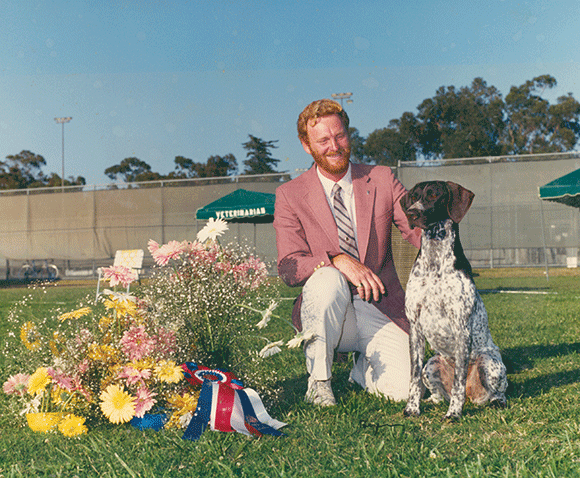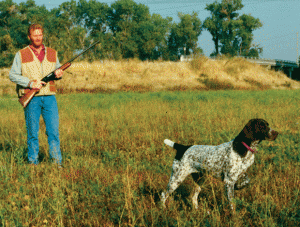Once in a Lifetime – The Story of Brit
Click here to read the complete article
74 – July, 2016
by Amy Fernandez
The world is justifiably fascinated with those perfect women who do it all, miraculously raising a brood of fabulous kids, juggling the demands of a high-powered career, finding time to pursue personal fulfillment, and somehow managing to star in that role, too.
Of course, experience regularly proves that it’s beyond the capabilities of most mortals to do it all. Despite that harsh reality check, we cling to the fantasy because every now and then we see it in action. ‘Brit’ ranks high on the list of those female superstars who inexplicably, effortlessly achieved that perfect balance in life and exceeded every expectation of her.
Formally known as BIS/BISS/NSC AM./CAN. CH. DC NMK’S BRITTANIA V. SIBELSTEIN HOF ROMX, she was at the height of her career in 1988 when The New York Times summed up competition at the 112th Westminster?Kennel Club saying, “Quality is the keynote.” A daunting number of canine superstars topped that year’s 2,649 dog entry including three returning group winners: the Peke, Ch. Briarcourt’s Coral Gable; the Bloodhound, Ch. Viking’s Thor, and Brit, who came into it as 1987’s Number One Sporting Dog. Needless to say, Westminster is what it is. None of them went home with the big prize that night. (That year it went to the Pomeranian, Ch. Great Elms Prince Charming II) Brit made it all the way to the final round for the second time, but a Westminster Best remained one of the few achievements that didn’t figure into one of the most spectacular careers in Sporting dog history.
Bred by Kathy Sibley, she was campaigned for owners Dr. Gary Stone and Carol Chadwick by Bruce Schultz who joined Brit’s team with some definite opinions about German Shorthaired Pointers. “I grew up in Minnesota where my first dog was a German Shorthaired Pointer from Armstrong Kennels, which was a field trainer.” He was more than familiar with the breed; he saw some of the best doing what they do best.
Minnesota can fairly be called ground zero of American Shorthair development. Like ice fishing, the breed simply came with the package in that part of the country. Oak-Crest, Kaposia and many other crucial bloodlines coalesced around those time-honored traditions of Minnesota sport hunting. Although most of them were originally attracted to the breed’s versatile talents in the field, they consistently promoted Shorthairs in conformation. For instance, in 1956 Ch. Oak-Crest Cora v. Winterhauch became the breed’s first Best In Show winning bitch. Show wins were the icing on the cake because, first and foremost, the Shorthair was a Gundog.
After moving to Arizona in 1971, Bruce put an obedience title on his first Irish Setter. He recalls, “A few years later I bought a show Irish Setter bitch and it all started from there. I worked hard for a handler, learning the right way to do things, and showing some beautiful dogs.”
He quickly transitioned from Bob and Patty Grant’s client to their apprentice, and by the mid-70s Bruce Schultz launched one of the hottest careers in the history of professional handling. “Showing dogs has been so rewarding from winning Quaker Oats and Handler of the Year awards to winning over 300 Best in Shows, 50 national specialties, multiple group wins at Westminster and piloting many dogs to number one in their respective groups.”

Obviously, Brit wasn’t his first show dog, but he explains that she was something special from the start. Her sire’s contribution came down from “the famous Columbia River and Gretchenhof bloodlines which have provided the foundation for so many great show dogs of the past and present.” The dam’s side of her pedigree was rock solid field stock. Bruce tells us, “Between them, the genes clicked. They produced the top winning German Shorthaired Pointer of all time!”
Yes, they did, and it was no small feat because that Gretchenhof/Columbia River blend of show and field stock was producing a formidable number of major league winners by that time. Their chart toppers included 1963’s Number One Sporting Dog, Ch. Gretchenhof Moonshine. A decade later, Brit’s great grandsire, Ch. Gretchenhof Columbia River, reset the bar for Shorthairs. ‘Traveler’ finished 1973 as Number Two Amongst All Breeds and the year’s top Sporting dog with 60 Group wins. His career total added up to 99 Group Firsts and 26 BIS. As we know, that last one was Westminster 1974. Case closed and a fitting end to a great career.
Shorthairs were definitely contributing their share of trouble to the Sporting Group by the time Brit arrived at Carol Chadwick’s Northwood Mountain Kennels in Middletown, California. Founded two years before Traveler’s milestone win, her NMK breeding program was predicated on those longstanding traditions of balance and versatility. NMK produced record numbers of dual champions and Brit’s bird sense was obvious from the start. Her astounding potential as a show dog also became apparent pretty quickly. By the time she was 13 months old, Chadwick had shown her to three Breed wins over specials and a Group Second. Within the next two months they picked up three Best In Specialty Shows, a Group First, and a few other jaw dropping wins.
Bruce says, “I was showing a bitch named Zoey for Carol Chadwick that she wanted me to special, but I had heard she had a younger bitch that was really nice. Carol asked why I wanted to see the young bitch since Zoey was the one she wanted to show. I finally convinced her to bring her out. At first sight, I knew she was going to be a great show dog. Here was the beautiful Brit at 13 months. She was stunning.”
Like those superwoman stories always go, “Everything just fell into place”. The reality is usually not so smooth and easy, but that’s exactly what happened when Bruce met Brit. “I was showing a Golden Retriever for Dr. Gary Stone at the time. We were getting ready to retire him so I asked Gary if he wanted to become a backer on Brit. He asked if we could take her to a few shows to see what she would do. A month later we took her to her first shows and she won back-to-back Group Firsts. At 14 months, she beat his top-ranked Golden. We put her away for a few months and the rest is history,” Bruce says with a chuckle.
Brit’s career was no run-of-the-mill show campaign. After all, what’s a girl to do? Someone had to step up and settle this whole Shorthair issue for once and for all. She got down to business. Of course, she did it on her terms. Bruce says, “Throughout her show career I had to run her in the field, which meant that I had to find places to do that at every show circuit. Otherwise she would go out of her mind wanting to run!”
There were the occasional complications. “One week on the Idaho and Montana circuit, she cut her foot out in the field and she needed five sutures.” Normally, that sort of thing means pack up and go home, but Brit was a trooper. “During that four day circuit we won three out of the four Best In Shows. Even though she tore out her stitches every day, she never missed a step and was never lame! She had heart.”
“I have so many great memories of showing Brit, but there are four shows in particular I will always remember. Two back-to-back BIS at Santa Barbara when she defeated 4,000 dogs each day and also her back-to-back Group First wins at Westminster,” he says.
During her two year show campaign, Brit defeated over 110,000 dogs. She was the top-ranked Sporting dog in 1987 and retired with a career total of:
49 all breed Best in Shows
141 Group Firsts
13 Best in Specialty shows
1 National Specialty
After retiring from the ring, she produced 19 champions including several dual bench and field champions. That’s pretty amazing, but this is the story of a superwoman kinda dog!
Bruce says, “In addition to being a great show dog, she was also a great field dog. I know because I did both with her! When I was showing her in New Mexico, Terry Chandler, a field trainer, invited us over for dinner. After dinner Terry asked if I wanted to see how a great field dog ran. I accepted and after watching his dogs run I asked him if he wanted to see Brit. He kind of laughed and agreed. He was amazed to see so much style and natural ability in a show dog. After Brit retired from the show ring, Terry became her field trainer. Yes, she also became a national field champion.” If that’s not enough, consider that she was 7 ½ years old when she did it.
Shorthair popularity has continued to climb since those days when Britannia ruled the breed. She obviously had a hand in that momentum. In addition to her genetic legacy, Brit’s phenomenal career redefined the concept of Shorthair versatility. And that, Bruce emphasizes, is the cornerstone of German Shorthair type. “I think the German Shorthaired Pointer is still a wonderful breed but the breeders need to sit back and take a hard look at their breeding programs and keep the Shorthair’s basic purpose in mind. Otherwise, they risk losing those critical elements of type.” He’s watched other breeds go down that road. He says,“So many Sporting breeds lack correct front assembly. They have lost that functional balance between the front and rear, which means they cannot work all day in the field.”
Dogs like Brit come along once in a lifetime. She did it all and Bruce considers himself fortunate to have been part of that. He’s also been in this sport long enough to know that there’s much more to it than show records. “If I wasn’t showing dogs, I would never have met some of the special people I’m blessed to have in my life.” That includes one particular superwoman Shorthair named Brit.

Short URL: http://caninechronicle.com/?p=107863
Comments are closed













